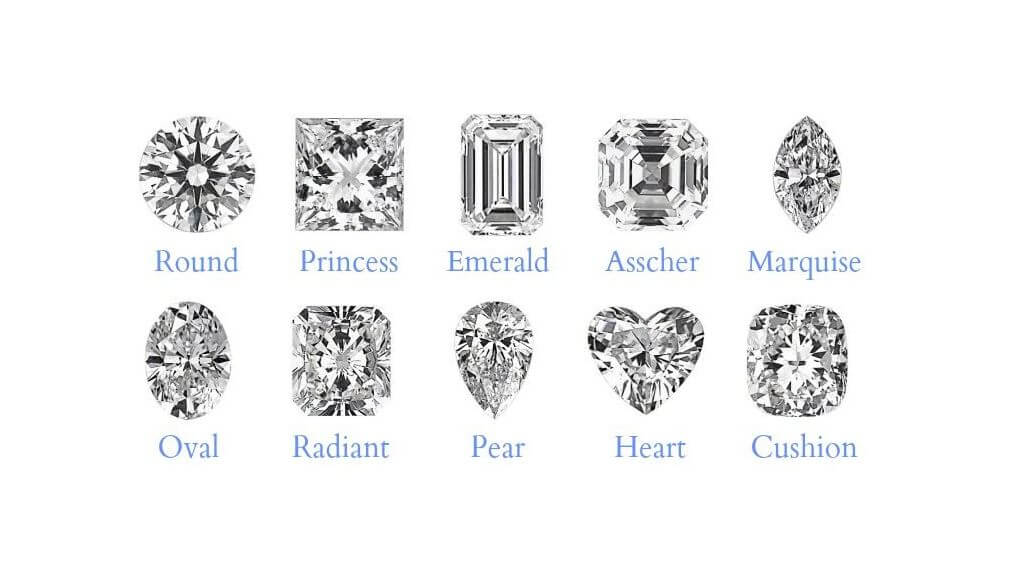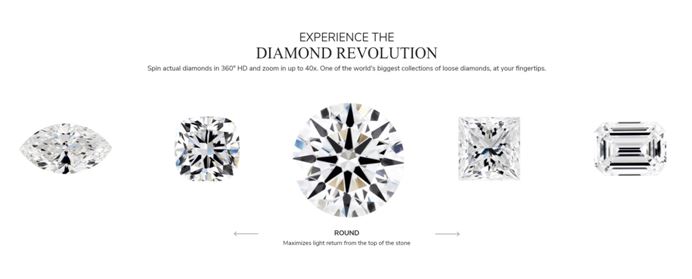A diamond, at its most basic level, is just a stone, the hardest stone on earth. So where does it derive its immense value? The cutting! The cut determines its brilliance, its beauty, and its value. A poorly cut diamond is less brilliant, less attractive, and most certainly undesirable. To that end, a plethora of diamond shapes have been invented in a bid to satisfy the insatiable tastes and preferences of jewelry enthusiasts.
One of the earliest shapes, the oval, is one of the most sought after shapes due to its excellent brilliance properties. Some more recent shapes like the emerald and the heart have gained favor with gemologists due to their uniqueness. Below is a compilation of the top 10 best diamond shapes ranked according to their brilliance, appeal, appearance, price/size ratio, and their popularity.
1. Round cut
The round cut diamond remains one of the most sought after diamond shapes of all time. This diamond shape accounts for more than 75% of all diamonds sold in the market, and it deserves the demand. When well cut, a round diamond has maximum brilliance and fire of any diamond shape. However, the price of this shape is higher than other shapes by 30-35% owing to the loss sustained when cutting it. To make the round cut, most of the stone gets lost in the process. The demand also plays a major role in maintaining the high price, but it’s all worth it.
Round diamonds have become a staple in engagement and wedding rings. The round shape maximizes the fiery and brilliance of the diamond giving it the most appealing look for all types of jewelry. As if that’s not enough, round diamonds retain their value over a long period of time and can therefore serve as a long-term investment.
2. Oval cut
The oval cut diamonds takes the second spot due to its uniqueness, brilliance and fiery. Since its creation in the 1960, this diamond shape has grown in popularity especially for customers who want a round diamond but prefer something a little unique. It possesses similar brilliance as a round diamond. However, it appears larger due to its large surface area. Furthermore, the elongated shape gives the illusion of a longer finger, something most customers find attractive. This shape is especially preferred for rings and necklaces. The price size ratio is similar to that of a round diamond. However, being that it appears larger, it may give the illusion of a larger diamond at the same price as a round diamond.
3. Princess cut
If you’re looking for a fancy cut diamond without breaking the bank, the princess cut diamond scoops the medal. This diamond shape goes at a lower price per carat compared to the above two attributed to less wastage of the rough stone during cutting. The stone that makes a round diamond can be used to make two princess-cut diamonds, hence the discount. It equally espouses similar brilliance and fiery. The diagonal length of a princess cut diamond is 15% more than the diameter of a round cut diamond, carat weight kept constant. This gives the illusion of a larger diamond when viewed from the top. This square-shaped diamond can come as a rectangular shape but at a discount. However, it depends on the tastes and preferences of the buyer. This cut diamond fits perfectly almost with any setting.
4. Marquise cut
Marquise diamond shape takes the fourth spot owing to its elongated shape that gives it the largest crown surface area. It therefore maximizes perceived size of a diamond compared to its price. Like the oval shape, the marquise diamond makes the finger of the wearer appear even longer, a desirable trait by most jewelry enthusiasts. The price size ratio is considerably low as a marquise diamond maximizes the rough stone with little wastage. The discount is translated to the buyer. The best marquise diamonds have perfectly symmetrical sides which are essential to avoid an off kilter look in the final setting.
Marquise diamonds possess the bow-tie effect, which may or may not be desirable. A large bow-tie effect will reduce the brilliance of the diamond. However, a subtle one gives the diamond peculiar beauty and uniqueness. Care should be taken to ensure the two tips of the diamond are set appropriately using prongs to avoid chipping since they’re sharp and pointy. All in all, it’s a perfect diamond shape for rings.
5. Cushion cut
Cushion cut diamonds are one of the oldest diamond shapes, having been in existence for more than 200 years. They give off an antique feeling and are desired by many vintage lovers. This shape combines the round and square shapes to give off a pillow-like shape. The modified cut has extra facets along the girdle that give unique patterns and enhances its beauty. While its brilliance may not match that of a round-cut diamond, it has a better fire giving off spectacular color dispersion.
Cushion cut diamonds can virtually fit in any setting and are perfect for almost all types of jewelry. The shape, however, requires more weight to be formed and hence may be a little expensive than other shapes, ceteris paribus. Consider this shape if you want that spectacular antique feeling.
6. Pear cut
The modified brilliant cut pear diamond possesses a unique shape combining round and marquise shape. It essentially resembles a tear drop but the length width ratio can be modified to alter the shape significantly. Ideally, the best L/W ratio that gives a perfect tear drop shape is 1.40-1.70. The brilliance of this shape is substantially excellent. However, it possesses the bowtie effect although not as substantial as in a marquise shape. The price/size ratio is significantly smaller compared to other shapes owing to its shape which has reduced weight under the rounded side.
This shape when set in a ring is always worn with the sharp end pointing the hand of the wearer. It’s also perfect for earrings and necklaces and can be used to symbolize different emotions such as tears of joy, sadness, blessings, and much more.
7. Heart cut
The heart shape is an unmistakable shape of love, and the modified brilliant-cut heart-shaped diamond delivers this emotion perfectly. Perfect for engagement rings or gifts of love, heart-shaped diamonds exudes enough brilliance and fiery and are modified from a tear-shaped diamond. Perfect symmetry is important to ensure there are no inclusions as well as maximizing the brilliance. The ideal length width ratio is 1.00 but buyers prefer a slightly thinner diamond when set in a necklace and a wider one when set on a ring. It is important to ensure that the heart-shaped diamond is set on a three-prong setting to preserve the shape, rather than a four-prong or circular setting. Also, you need a slightly larger diamond for the shape to be visible by the naked eye, meaning extra carats. It is one of the most expensive shapes.
8. Emerald cut
If you’re looking for a unique, intriguing diamond shape, then go for the emerald diamond by all means. This shape is not designed for brilliance and fiery, but for its unique step cuts that create a hall-of-mirrors effect, with the interplay of light and dark planes. It however emits dramatic flashes of light that gives it a unique edge over other shapes. Usually, the emerald diamonds are rectangular in shape with the ideal L/W ratio being 1.5. This shape is ideal for necklaces but won’t sit well with rings. The price size ratio is significantly lower and the price of a round cut diamond will fetch you a significantly larger emerald diamond.
9. Asscher cut
Asscher and emerald are both similar in that they have the same structure of the cut. However, the Asscher diamond is a square emerald, as defined by the GIA, with larger step facets, a higher crown, and a smaller table. A perfectly cut diamond with perfectly aligned pavilion facets produces unique pattern of concentric squares that are beautiful and appealing to the eye. The cropped corners of the Asscher give the diamond an octagonal shape and it’s easy to observe the shape on a four-prong setting. The ideal L/W ratio is 1.00 and any deviations from this ratio will give off an emerald-like shape.
10. Radiant cut
This cut diamond is derived from the first square cut and has facets on both the crown and the pavilion. The princess diamond is cut from this diamond cut. These facets on the pavilion and the crown create a lively square diamond. The corners of the diamond are cropped to give an octagonal shape just like the Asscher. It’s a nice bridge between the cushion and princess cut diamonds. The more rectangular the diamond is, the greater the bow-tie effect.

